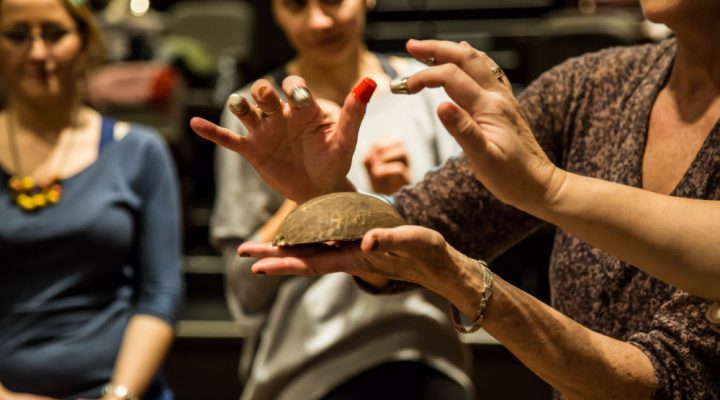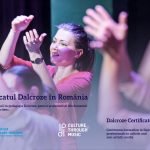About Active Pedagogies
We generally speak about active pedagogies when the student holds an active position.
Active pedagogies rely on the following pedagogical principle: the student is an actor in the learning process; he discovers and builds knowledge through real play, through personal or group research. In the case of active musical pedagogies they are ‘active’ not only through student’s positioning in the learning process, but also through the importance given to body expression, to movement in the music learning process.
Pedagogical Formula
We may distinguish two main pedagogical formula:
The Up to Down formula: Knowledge results from an exchange starting from the teacher and reaching the student. The teacher lectures and the student listens, while trying to understand it. This is the ‘talking professor’ pedagogy, largely used in the traditional system.
The Down to Up formula: The student actively searches for information and does so through discussion, reflection, play, teamwork, all this with the aid of the trainer that is ready to inform, guide and encourage him all the way in this process. This is the ‘supporting professor’ pedagogy, proposed by the active pedagogy.
Active Learning Methods
The main active learning methods in music are established during the two World Wars. These new forms of teaching music are due mostly to an important research movement in the area of education, done at that moment. Notably Maria Montessori’s activity who considers that the main objective of education is not the transmission of information, but genuine child development. Later on, Celestin Freinet insists upon child’s freedom of expression and team work.
Active learning methods are inline with a transmissive learning process where the capacity to build knowledge through correlation of different concepts is key. Knowledge accumulation is not as relevant. Active pedagogies favor teamwork and ensures a positive dynamic through a better interaction among students.
Active musical pedagogies are applicable in both musical theory learning as well as in playing an instrument. Active methods offer a rigorously planned education depending on child psychological development stage. Mostly through activities relying on play, children experiment with music before learning about rules. Here, imitation of the model proposed by the teacher plays a major role. Step by step, children acquire decoding abilities as well as theoretical knowledge for tonal music.
Through active musical practice, children develop their musical senses.
A Bit of History
At the beginning of the 20th century, many musicians and teachers were interested in early musical education. Their research and experiment led to new specific methods, generally acknowledged as active pedagogies. Mary Jaëll (1846-1925 France), Émile Jaques-Dalcroze (1865-1950, Switzerland), Edgar Willems (1890-1978, Belgium), Carl Orff (1895- 1982, Germany), Maurice Martenot (1898-1980, France), Zoltan Kodaly (1882-1967, Hungary) have developed methods bearing their names and found inspiration in modern pedagogy approaches.
Major Active Pedagogies
Carl Orff Musical Pedagogy is not a method stricto senso, but a body of knowledge guiding the teaching process whose main objective is to promote children harmonious development through elementary music and movement. Non-elitist and playful this pedagogy addresses everyone, not just children. It is practiced in groups and uses a small paercution set (xylophone, metallophone) generically named ‘instrumentarium Orff’. This pedagogy uses as support the traditional repertoire of all cultures, promoting creation and improvisation. Singing, dancing, movement, drama, body percution are just as important as musical theory and the instrumental technique.
Source: www.orff.fr
Willems Musical Pedagogy is based on several fundamental principles:
-
Musical education shall be a means of human kind development. Each child, gifted or not shall benefit from this ‘basic cultural element’, that is music.
-
Musical training is of primary importance. “Once initiation is well thought, the rest is a logical flow, according to the laws of life.” Musical initiation is based on student’s active participation through sons, musical audition exercises, rhythm, body movement, starting 2-3 years prior to studying musical theory or playing an instrument.
-
The practice must be preceded by formal, theoretical knowledge. Thus, it is necessary to highlight the lively sources of music: rhythm, melody, harmony, improvisation, composition. For Willems, the lively sources of musical elements are to be found in man, in his motive, sensory, emotional and mental nature – that is in the human being as a whole, in harmony with the universe.
Source: www.fi-willems.org
Martenot Musical Pedagogy has as main objective the development of sensible, body and intellect qualities of the human being.
-
Arts are part of education
-
The human being is a whole
-
The sensible leads to intellect (practice precedes theory)
-
The muscular memory is ineffaceable
-
Approaching difficulties one by one makes learning easier
-
To be a musician means to think music
-
The playful spirit relates to qualitative efforts
-
Learning is never failing
Source: www.centremartenotkleber.net
“Following a certain order, a firm structure and through a climate of trust and joy we open the door to improvisation and creativity – everything becomes possible.”
(M. Martenot)
Dalcroze Musical Pedagogy stresses the natural connection between body movement and music. Through the body, the musical and artistic faculties are naturally developed, around three pillars:
rhythm, solmization and improvisation. Rhythmic for example, is approached while stimulating the global motive abilities, the perception and acknowledged body movement. The human body is musician’s first instrument, that allows him to live and transmit his musicality.
Similarly, the solomization is fixed through body experiment, through improvisation, reaction and coordination or dissociation. Body memory will serve as a basis for association between the lively experience and a theoretical concept.
Source: www.dalcroze.ch
Kodaly Musical Pedagogy (that was established later on based on the philosophical grounds on musical education, issued by Kodaly) has strongly impacted the Hungarian music school.
Music plays an important role in the general curricula for primary schools. Kodaly insisted on the importance of teaching music in school. In no case should musical practice be ‘reserved’ to a small number of children, ‘gifted for music’. Singing (a special interest for ‘folk or traditional songs’ is considered the way to music – allows you to perceive music directly, without the mediation of an instrument. He recommends a musical initiation as early as possible. Learning music starts with listening, singing and movement before reaching theory. Source: www.kodaly.hu
Features
It it vital to acknowledge the great contribution of active methods to the dynamic of worldwide musical pedagogy.
The active models have in common a set of fundamental pillars:
-
a global approach regarding the child and the music in all its aspects (body, intellect, psychological, cultural, collective);
-
A dynamic pedagogy that starts from experience, from senses and leads progressively towards the theoretical notions
-
the importance of the development of inner listening, creative and improvisational abilities
-
the important role of singing
-
group learning
-
play as main dynamics for learning (that does not impede following a certain learning program, defined according to specific objectives)
A possible solution for a pedagogical qualitative approach would be to never allow yourselves ‘stuck’ in a certain method or thinking school and to always search for inspiration in the diversity of all that is being offered. Each professor should be able to identify the contribution of various pedagogies and interpret and integrate it in a personal manner. The true talent of an educator is finding the most suitable path for each student. The entire process starts from one’s wish to improve their professional performance.
All music professors and educators should have the opportunity and the wish to improve their performance, either during their studies or through constant professional training, in various active pedagogies such as: Martenot, Orff, Dalcroze, Kodály, Marie Jaëll Montessori , Willems. Gordon and the list may continue.
This is one of our main objectives: to offer you high quality professional training, led by international trainers. This will bring a new perspective to the wonderful role that musical education can play in your professional life.










